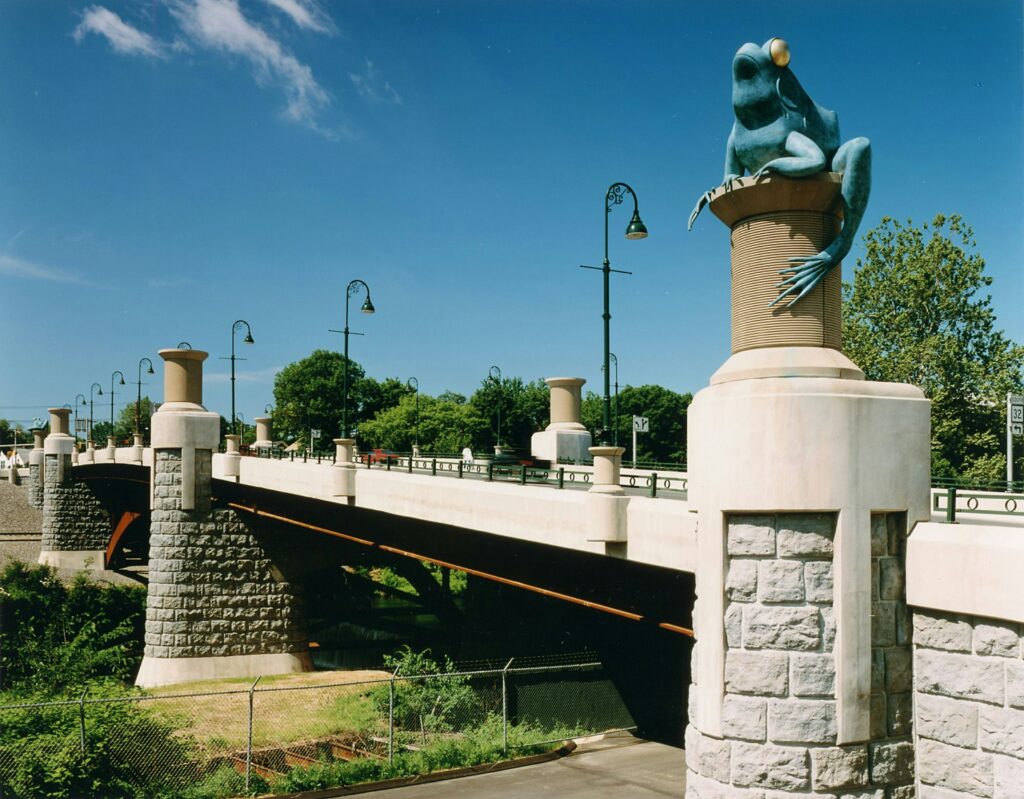By ALIX BOYLE
The next time you’re in Windham, make sure that you visit the bridge spanning the Willimantic River. You’ll see giant spools of thread with frogs sitting atop them. Many people know that Windham was a mill town and produced some of the finest sewing thread in the U.S. But those amphibians you may not have heard about. They commemorate the story of the Great Windham Frog Fight.
The event that inspired the folktale occurred around 1754. It was recorded in Rev. Samuel Peters’ General History of Connecticut. Peters was a Connecticut native, from Hebron, and a student at Yale, said Co-Windham Town Historian Jamie H. Eves, a history instructor at University of Connecticut, on the Windham Textile and History Museum website.
But Peters was also a fervent Loyalist at the time of the American Revolution, harassed, harried and threatened by his Patriot neighbors, and driven into exile in 1774. His book—including the part about the Windham Frog Fight—was a bitter attack on Connecticut’s Patriot leaders that frequently shaded the truth in order to make the Patriots look bad, according to Evers’ account. Eliphalet Dyer and Jedidiah Elderkin, leaders on the Patriot side, were portrayed as bumbling idiots and comic cowards.
In Peters’ telling, one dark summer night in 1758, an army of noisy frogs marched (hopped?) into Windham village (now known as Windham Center), startling residents. Hearing the racket and convinced it was an invading force of French Canadians, Algonquins and Wabanakis, the women cowered and the men—led by Dyer and Elderkin—abandoned their families and ran, hiding in the woods. Eventually, the men returned, attempted to negotiate with what they still believed to be human enemies, and—once they realized that the invaders were frogs—did battle with them, slaughtering thousands. Unfortunately, other late 18th- and early 19th-century writers accepted Peters’ account uncritically, in part because it provided wags from surrounding towns the opportunity to poke fun at folks from Windham.
Word of the battle of the frogs spread throughout colonial America and Windham became a bit of a laughingstock. The townspeople adopted the bullfrog as an emblem.
But what really happened? About 100 years later, Windham resident William Weaver did a historical study and, “concluded that the residents of Windham village had indeed been awakened on a dark summer night in 1758 by a raucous racket they could not identify and, yes, they had wondered if it could be an invading force of French, Algonquins and Wabanakis. Investigating the next day, they found the bodies of hundreds of frogs in and around the town’s millpond. Something had killed the frogs, and they had been loud in their dying, but no one knew what. Weaver thought that the frogs most likely had killed each other, although why they would have done so was a mystery,” Eves wrote.
Eves has taught this story to students at University of Connecticut and Eastern Connecticut State University and hopes that it is taught in the Windham schools. The millpond has since been renamed Frog Pond and there is a frog on the town seal.
Windham Mayor Tom DeVivo loves the story. “The entire story is amusing,” he said. “My favorite part is when the sun rises, and the farmers and townsfolk discover their mistake. It seems like something made up, yet why not believe? The story brings smiles, laughs and generally good will and isn’t that something we all crave?”






More Stories
Over 50, Underestimated: The Grandfluencers Redefining Age on Social Media
Building Resilient Businesses: Strategies for Success
Summer Means Convertibles